Uganda’s Bahai Temple
Uganda’s Bahai Temple : has unique architectural design that stands tall in the middle of the green conical dome shape made of tiny glazed mosaic tiles. Additionally, it has 9 big pillars and 27 small pillars that support the temple stand up right. The temple was constructed between years 1956 and 1961 and its located on kikaaya hill 4 miles from Kampala on Gayaza road. The Bahai faith was introduced by a man from Iran called Baha’u’llah in 1844. His name means “The glory of God” and he also wrote the Bahai faith.
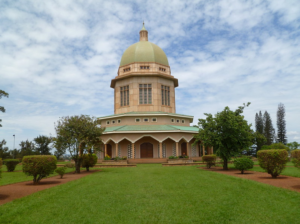 The temple is a house of worship also known as Mashriq I’-Adhkar, and open to all people in the world acting as a spiritual gathering place. As a matter of fact, there is only one Bahai temple in each continent and Uganda has the mother temple in Africa. Besides, this faith was introduced to Uganda in 1951 making it one of Eastern Africa’s earliest Bahai communities. In fact, the temple is one of the unmissable tourism sites while on your city tour. Otherwise, the temple has an evergreen compound with nice gardens where one can have a good view of the city while on a high point.
The temple is a house of worship also known as Mashriq I’-Adhkar, and open to all people in the world acting as a spiritual gathering place. As a matter of fact, there is only one Bahai temple in each continent and Uganda has the mother temple in Africa. Besides, this faith was introduced to Uganda in 1951 making it one of Eastern Africa’s earliest Bahai communities. In fact, the temple is one of the unmissable tourism sites while on your city tour. Otherwise, the temple has an evergreen compound with nice gardens where one can have a good view of the city while on a high point.
Rules that govern the temple and faith
Like any other religion, Bahai as a faith and temple has different rules and regulations that are supposed to be followed. These are to be followed while inside and outside the temple not forgetting during prayers. Below are some of the rules;
Family and marriage life
Marriage is not prohibited in the Bahai faith though it’s not obligatory according to the teachings of this faith. However, the marriage of the Bahai faith has requirements and these include partners having the approval of their living biological parents. In addition, they should be above the age of 15 years so as to strengthen ties between the two families. Besides, a man and woman who are married are the only ones allowed to have sexual relationships. Note that, sexuality is normal in the marriage life since it enhances the relationship. Interracial and interreligious marriages are allowed, divorce is permitted though discouraged. However, if the couple is unable to reconcile after a year of separation then divorce is granted.
Prayers
Bahai faith has two distinct types of prayers and these include devotional prayer (general) and the obligatory prayer (individual). However, for this prayer you’re supposed to face the Qiblih and it should be recited every day. Prayer is part of the most important act in the Bahai law because it helps in self-discipline and enjoined to pray daily. Furthermore, the Bahai faith prayer is believed to get you closer to God and to Baha‘u’llah, requesting for divine assistance. However, the devotional prayer in the Bahai directs believers to meditate and study sacred scriptures. The devotional prayer is written by the central figures of the Bahai faith and collected in prayer books which are held in high esteem.
Alcohol and drugs
Apart from the doctor’s orders, taking of drugs and drinking alcohol are prohibited in the Bahai faith. God gave human beings reasons which are taken away by intoxicants leading to mind astray. However, smoking of tobacco is discouraged but not prohibited.
Fasting
The fasting period in the Bahai faith generally takes place from March 2nd to 20th March and this fast is a nineteen days period. Above all, one has to be in good health ranging from the age of 15 to 70 years. Additionally, it’s a sunrise to sunset fast without eating and drinking. This fasting works hand in hand with the obligatory prayer since it helps in bringing people closer to God and reinvigorate the soul. However, people who are nursing, menstruating, ill, pregnant, travelling, and engaged in heavy labor are the only ones excused. The fasting is not forced by the Bahai law since it’s an individual spiritual obligation.
Gossiping
Relationships and individuals are damaged by this practice and it also has a negative effect on the community as well as people involved. Therefore, it is considered a sin and hated human characteristic and it’s prohibited by the Bahai law.
Other laws talked about in the holy book
- Consumption of dead animals is not allowed.
- Saying the greatest name (Baha’u’llah) 95 times a day.
- Teaching children the Bahai faith is compulsory for the Bahais.
- After death bodies should be wrapped in cotton and put in a coffin made of polished stone with hard wood. Otherwise, it’s forbidden after death to carry the body for more than an hour’s journey from the municipal boundaries where death occurred.
What can one do while at Bahai temple?
Different interesting activities can be done while Bahai Temple and some of these include;
 Spiritual gatherings
Spiritual gatherings
During this activity individuals in groups gather to share prayers to help them strengthen the unity in the Bahai faith. They hereby share their stories and play music for different individual’s interests. However, these gatherings are mainly for uniting souls present through the power of prayer from different individuals.
Bird watching
With the different tree species and flowers, this temple harbors different bird species. Some of these include; the great blue turaco, stripped kingfisher, hadada ibis, grey parrot. Grey woodpecker, bronze sunbird, brown parrot not mention but a few. Therefore, making it one of the best destinations for the bird lovers since you can’t fail to spot any of those different birds.
Camping
Junior youths believing in the Bahai faith at the age of 11 to 14 years basically go for camping at the temple. While here, they get involved in youth classes to develop their spiritual intellectual capacities. In addition, they are taught to express their powers through drama, art and craft, singing, making of moral decision, etc.
Location of Bahai Temple?
This temple is located on Kikaaya hill in Kanyanya 3km north of Kampala approximately 7km on Gayaza road.
How to get to Bahai Temple
The Baha’i temple of Africa is situated in north Kampala about 3 miles along Gayaza road in central Uganda. The place can be accessed by road transport from Entebbe International Airport and its about 46.5 kilometers via Entebbe express high way. In other wards, it takes about an hour or even less to arrive at Baha’i temple.

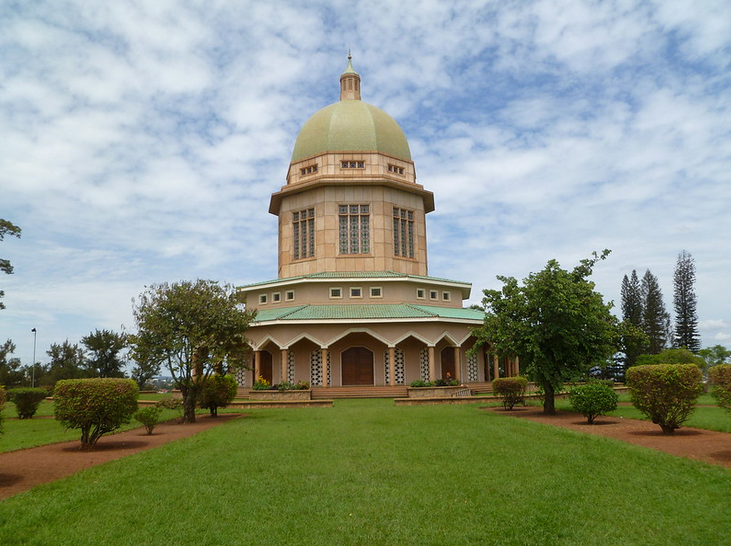
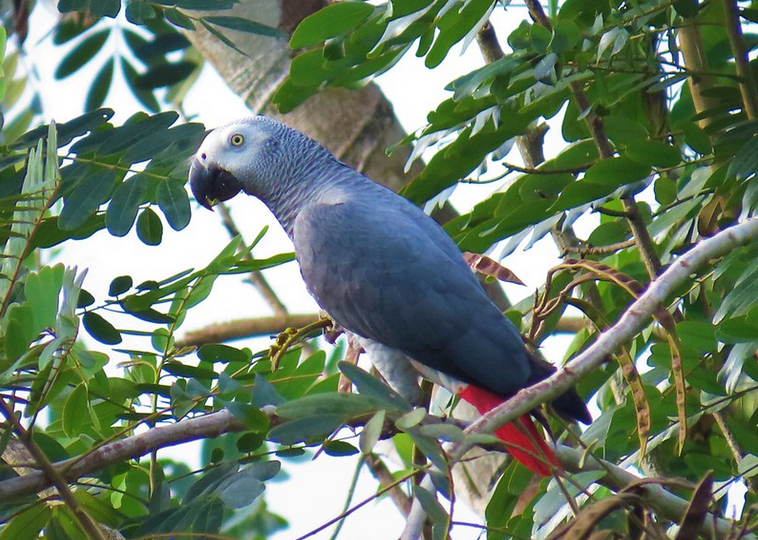
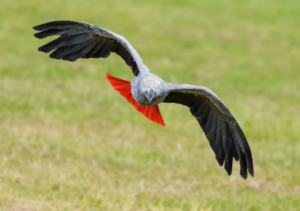 Many of the grey contour feathers are edged with white, giving them a smooth, lacy appearance. In fact, at a certain degree, they tend to be sexually dimorphic. One can basically differentiate the sex of these birds once the birds is nearly 18 months of age. Here, the male parrot’s tail remains solid red while a female’s tail becomes red but tipped with silver. The underparts of the male’s wings become dark while for the female’s remain light. Secondly, sex can be differentiated according to the size whereby males have a more slender and narrower head. On the other hand, the females have got longer necks with larger and rounder heads.
Many of the grey contour feathers are edged with white, giving them a smooth, lacy appearance. In fact, at a certain degree, they tend to be sexually dimorphic. One can basically differentiate the sex of these birds once the birds is nearly 18 months of age. Here, the male parrot’s tail remains solid red while a female’s tail becomes red but tipped with silver. The underparts of the male’s wings become dark while for the female’s remain light. Secondly, sex can be differentiated according to the size whereby males have a more slender and narrower head. On the other hand, the females have got longer necks with larger and rounder heads.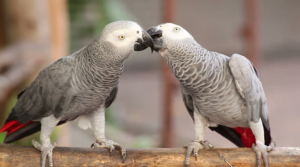 Unlike other parrots that are often found in mixed flocks, these flocks always comprise of only African grey parrots. Furthermore, during the day, they break into smaller flocks and fly longer distances to forage. The young birds stay with their family groups for a long period of time for several years. They socialize with others of their agemates in nursery trees, however remain in their family groups within the larger flocks. They are also cared for by older birds until they are educated enough and old enough to become independent flock members. The young need to learn a complex set of skills such as differentiating desirable food plants from toxic plants, how to recognize and avoid predators, how to defend territory, etc.
Unlike other parrots that are often found in mixed flocks, these flocks always comprise of only African grey parrots. Furthermore, during the day, they break into smaller flocks and fly longer distances to forage. The young birds stay with their family groups for a long period of time for several years. They socialize with others of their agemates in nursery trees, however remain in their family groups within the larger flocks. They are also cared for by older birds until they are educated enough and old enough to become independent flock members. The young need to learn a complex set of skills such as differentiating desirable food plants from toxic plants, how to recognize and avoid predators, how to defend territory, etc. The breeding season varies by locality however appears to coincide with the dry season. These grey parrots usually breed twice a year and normally mate several times a day for several weeks before the first egg is laid. Females lay a clutch of three to five roundish eggs, each at intervals of two to five days. However, the females incubate the eggs while being fed entirely by the males. Incubation takes approximately (26-30) days with the average being 28 days. Fledgling from the nest is always at (10-12) weeks of age. After the young emerging from the nest, weaning takes another 3-4 weeks by both parents nourishing, raising and protecting their off springs until they reach independence.
The breeding season varies by locality however appears to coincide with the dry season. These grey parrots usually breed twice a year and normally mate several times a day for several weeks before the first egg is laid. Females lay a clutch of three to five roundish eggs, each at intervals of two to five days. However, the females incubate the eggs while being fed entirely by the males. Incubation takes approximately (26-30) days with the average being 28 days. Fledgling from the nest is always at (10-12) weeks of age. After the young emerging from the nest, weaning takes another 3-4 weeks by both parents nourishing, raising and protecting their off springs until they reach independence.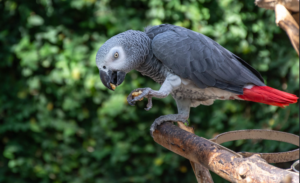 These birds are basically herbivores and frugivores which means that the vast majority of their diet consists of fruits. Their primary food sources are generally fruits, seeds and nuts. However, they are also known to eat tree bark, insects, flowers and snails. Their favorite food source in the wild is usually oil palm fruit. Besides, when searching for food, these birds fly or climb to the ground to forage for ripe fruit that has fallen from tress. The best food for an African grey parrot in captivity is a high-quality formulated pellet supplemented with fruits. These include; apples, pears, carrots, oranges, bananas, cucumbers, peas, celery, seeds, melon, etc. Additionally, they also provide fresh vegetables such as leafy greens like sprouts and healthy seeds like flaxseeds.
These birds are basically herbivores and frugivores which means that the vast majority of their diet consists of fruits. Their primary food sources are generally fruits, seeds and nuts. However, they are also known to eat tree bark, insects, flowers and snails. Their favorite food source in the wild is usually oil palm fruit. Besides, when searching for food, these birds fly or climb to the ground to forage for ripe fruit that has fallen from tress. The best food for an African grey parrot in captivity is a high-quality formulated pellet supplemented with fruits. These include; apples, pears, carrots, oranges, bananas, cucumbers, peas, celery, seeds, melon, etc. Additionally, they also provide fresh vegetables such as leafy greens like sprouts and healthy seeds like flaxseeds. 




